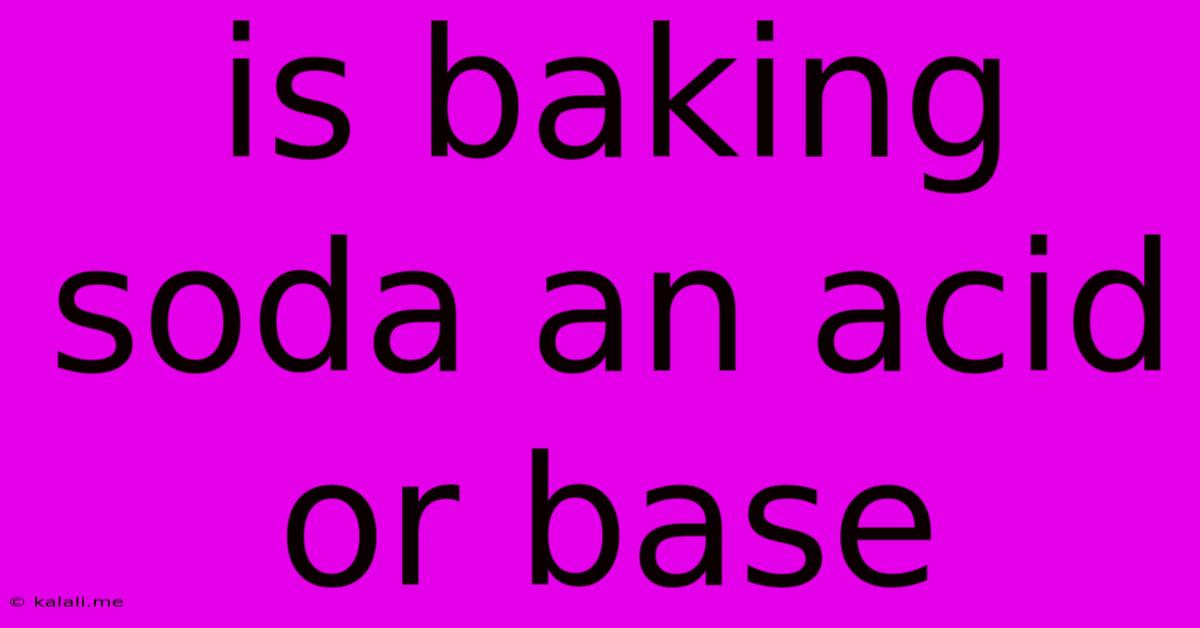Is Baking Soda An Acid Or Base
Kalali
May 23, 2025 · 3 min read

Table of Contents
Is Baking Soda an Acid or a Base? Understanding pH and Baking Soda's Role
Baking soda, a common household ingredient, is often the subject of confusion regarding its chemical nature. Is it an acid or a base? The answer is simple: baking soda is a base. Understanding this fundamental characteristic is crucial to grasping its uses in baking, cleaning, and other applications. This article will explore the concept of pH, explain why baking soda is a base, and delve into its chemical properties.
Baking soda, chemically known as sodium bicarbonate (NaHCO₃), has a pH greater than 7, making it an alkaline substance, or a base. This means it can neutralize acids. This characteristic is key to its function in baking and cleaning.
Understanding pH Scale
The pH scale measures how acidic or basic a substance is. The scale ranges from 0 to 14, with 7 being neutral. Substances with a pH less than 7 are acidic, while those with a pH greater than 7 are basic or alkaline. The further a substance is from 7, the stronger its acidic or basic properties.
Why Baking Soda is a Base: A Chemical Perspective
Baking soda's basic nature stems from its chemical structure and its reaction with water. When dissolved in water, sodium bicarbonate dissociates into sodium ions (Na⁺) and bicarbonate ions (HCO₃⁻). The bicarbonate ion can accept a proton (H⁺), a characteristic of a base according to the Brønsted-Lowry acid-base theory. This proton acceptance leads to the formation of carbonic acid (H₂CO₃), a weak acid that quickly decomposes into water and carbon dioxide. This reaction is what causes the fizzing effect often observed when baking soda is combined with acidic ingredients.
Baking Soda's Reaction with Acids: The Key to its Functionality
The reaction between baking soda (a base) and an acid is crucial to its functionality in various applications. This reaction produces carbon dioxide gas (CO₂), water (H₂O), and a salt. This gas production is what makes baking soda a leavening agent in baking. When combined with acidic ingredients like buttermilk, lemon juice, or vinegar, it creates bubbles that help baked goods rise.
- Baking: This is the most common use. The carbon dioxide generated provides lift and texture to cakes, cookies, and bread.
- Cleaning: Its alkaline nature helps neutralize acidic substances and dissolve grease, making it an effective cleaning agent.
- Deodorizing: It can neutralize unpleasant odors by reacting with and neutralizing acidic compounds responsible for those smells.
Common Misconceptions
Many confuse baking soda with baking powder. While both are leavening agents, they differ significantly. Baking powder is a mixture containing baking soda, an acid (like cream of tartar), and a drying agent (like cornstarch). It contains everything needed for a chemical reaction, while baking soda requires an additional acidic ingredient to create the leavening effect.
Conclusion
Baking soda is definitively a base, not an acid. Its alkaline nature is the key to its various applications, from leavening baked goods to cleaning and deodorizing. Understanding its chemical properties and reaction with acids is fundamental to appreciating its widespread use and versatility. By understanding the pH scale and the principles of acid-base chemistry, we can better understand the unique properties of this common household staple.
Latest Posts
Latest Posts
-
What Size Wire For 40 Amp Breaker
May 23, 2025
-
Why Does My Cat Lick My Hand
May 23, 2025
-
How To Get Gasoline Smell Out Of Hands
May 23, 2025
-
Does The Period Go Inside Or Outside Of The Parentheses
May 23, 2025
-
How Do You Get Scratches Out Of Stainless Steel
May 23, 2025
Related Post
Thank you for visiting our website which covers about Is Baking Soda An Acid Or Base . We hope the information provided has been useful to you. Feel free to contact us if you have any questions or need further assistance. See you next time and don't miss to bookmark.